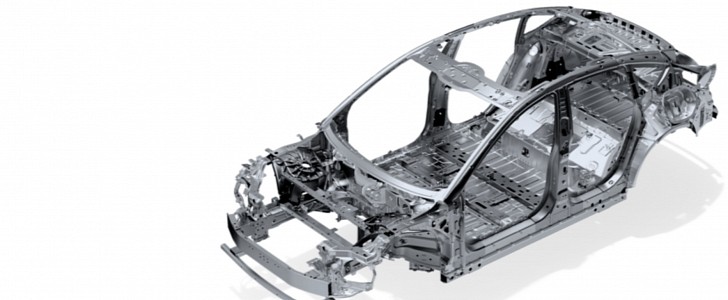Unlike BMW, NIO and XPeng seem convinced that massive casting parts may give them a manufacturing edge. Although they have not confessed they would adopt such components, some hints point in that direction, according to CNEVPost. Everything would be connected to Guangdong Hongtu.
This Chinese supplier works with both carmakers. On January 22, 2022, it held a ceremony to present a 6,800-ton die-casting press and announced a deal with LK Technology. Both companies will cooperate in developing a casting press with a 12,000-ton capacity. The agreement also informs that Guangdong Hongtu wants to “purchase eight sets of large-scale and super-large-scale intelligent die-casting units.” No supplier would make such an investment without companies wanting these parts.
CNEVPost reported rumors about six Chinese automakers wanting to use these giant cast parts. Tesla started adopting them, and the deal between Guangdong Hongtu and LK Technology shows there are no coincidences in this story. LK Technology owns IDRA Group, the Italian company that sold Tesla its “Giga Presses.”
The connection between this deal and the two Chinese carmakers CNEVPost mentions is not explicit. Zeng Shuxiang, NIO’s motor division XPT CEO, sent a video that was played at the ceremony to congratulate Guangdong Hongtu. Jiang Ping, XPeng’s vice president, was personally there to praise the supplier.
Other signs that these two companies may adopt these huge castings come from NIO. On October 18, 2021, NIO said it had developed a heat-treatment-free alloy. This is a crucial step for these massive cast parts to be economically feasible.
Apart from that, CNEVPost heard from William Li that the ET5 uses “an integrated die-casting process for the rear subframe.” The NIO CEO did not go further than that, but the material about the new car stated that it uses what the automaker calls an “integrated hollow cast-aluminum process.”
According to NIO, it would save 13 kilograms (28.7 pounds) in the structure, which would also be stronger than the stamped and welded rear subframe. Instead of 31 kNm/deg, it would offer 34 kNm/deg. The final advantage would be that the trunk could get 11 liters (0.4 cubic feet) more space with this giant casting.
If NIO and XPeng confirm they will use these huge cast parts, they will probably have to say why BMW is wrong in its assessment of them. When asked about them, Oliver Zipse noted that their “partially lower manufacturing cost is overcompensated by casting costs.” The BMW CEO is convinced that there are “much more efficient ways to build a car body.”
CNEVPost reported rumors about six Chinese automakers wanting to use these giant cast parts. Tesla started adopting them, and the deal between Guangdong Hongtu and LK Technology shows there are no coincidences in this story. LK Technology owns IDRA Group, the Italian company that sold Tesla its “Giga Presses.”
The connection between this deal and the two Chinese carmakers CNEVPost mentions is not explicit. Zeng Shuxiang, NIO’s motor division XPT CEO, sent a video that was played at the ceremony to congratulate Guangdong Hongtu. Jiang Ping, XPeng’s vice president, was personally there to praise the supplier.
Other signs that these two companies may adopt these huge castings come from NIO. On October 18, 2021, NIO said it had developed a heat-treatment-free alloy. This is a crucial step for these massive cast parts to be economically feasible.
Apart from that, CNEVPost heard from William Li that the ET5 uses “an integrated die-casting process for the rear subframe.” The NIO CEO did not go further than that, but the material about the new car stated that it uses what the automaker calls an “integrated hollow cast-aluminum process.”
According to NIO, it would save 13 kilograms (28.7 pounds) in the structure, which would also be stronger than the stamped and welded rear subframe. Instead of 31 kNm/deg, it would offer 34 kNm/deg. The final advantage would be that the trunk could get 11 liters (0.4 cubic feet) more space with this giant casting.
If NIO and XPeng confirm they will use these huge cast parts, they will probably have to say why BMW is wrong in its assessment of them. When asked about them, Oliver Zipse noted that their “partially lower manufacturing cost is overcompensated by casting costs.” The BMW CEO is convinced that there are “much more efficient ways to build a car body.”






